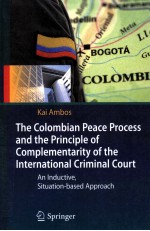

THE COLOMBIAN PRACE PROCESS AND THE PRINCIPLE OF COMPLEMENTARITY OF THE INTERNATIONAL CRIMINAL COURTPDF电子书下载
- 电子书积分:9 积分如何计算积分?
- 作 者:KAI AMBOS
- 出 版 社:SPRINGER
- 出版年份:2010
- ISBN:3642112722
- 页数:161 页
Part Ⅰ Law 975 and its process 3
Chapter 1 Preliminary Remarks 3
Chapter 2 The Process Under Law 975 11
2.1 Demobilization, disarmament and reintegration 12
2.2 Preliminary investigation and "version libre" 14
2.3 Formulation of"imputation"and charges 17
2.4 Reparation 21
2.5 Determination of the sentence 23
Chapter 3 Intermediate Conclusions 25
Part Ⅱ The complementarity test(Art.17)and its application to the Colombian situation 37
Chapter 4 Preliminary Considerations:The Object of Reference of the Complementarity Test(Situation-Case-Conduct) 37
Chapter 5 Gravity and Complementarity Stricto Sensu 43
5.1 Sufficient gravity(Art.17(1)(d)) 44
5.1.1 The standard in current practice 44
5.1.2 The own approach 48
5.1.3 Application to the situation in Colombia 51
5.2 Complementarity stricto sensu 54
5.2.1 Admissibility due to total State inaction 55
5.2.1.1 General considerations 55
5.2.1.2 Application to the situation in Colombia 57
5.2.2 Inadmissibility due to State action(Art.17(l)(a)-(c)and 20(3)) 59
5.2.2.1 General considerations 59
5.2.2.2 Application to the situation in Colombia 63
5.2.3 Admissibility due to unwillingness or inability(Art.17(2)and(3)) 63
5.2.3.1 Preliminary remarks 63
5.2.3.2 Unwillingness 66
a) General considerations 66
b) Application to the situation in Colombia 72
aa) Purpose of shielding 72
bb) Unjustified delay 73
cc) Independent and impartial proceedings 75
dd) General and paradigmatic aspects 76
5.2.3.3 Inability 80
a) General considerations 80
b) Application to the situation in Colombia 83
Chapter6 Conclusion:Classifying the Colombian Case with a View to Different Transitional Justice Scenarios 89
Chapter7 Some Recommendations for the Further Application of Law 975 91
Documents and Materials 97
1. Bibliography 97
2. Additional Sources 107
2.1 NORMATIVE FRAMEWORK 107
2.1.1 Legislation 107
2.1.2 Executive Decrees 108
2.1.3 Resolutions, agreements, memoranda and others 108
2.2 JURISPRUDENCE 111
2.2.1 International Jurisprudence 111
2.2.2 Colombian Jurisprudence 113
2.3 DOCUMENTS 116
2.3.1 Governmental documents 116
2.3.2 International and non-governmental organizations 119
2.3.3 Press reports 124
2.4 (Further)BIBLIOGRAPHY 126
2.4.1 Monographs/Books 126
2.4.2 Articles in journals/books 131
2.5 FIELD WORK:INTERVIEWS AND MEETINGS 134
2.5.1 Interviews 134
2.5.2 Meetings 135
3. LAW NO.975, 25 JULY 2005(English translation) 139
CHAPTER ⅠPrinciples and definitions 139
CHAPTER ⅡPreliminary aspects 142
CHAPTER ⅢProcedural principles 143
CHAPTER ⅣInvestigation and prosecution 144
CHAPTER ⅤAlternative Sentence 149
CHAPTER ⅥRegime for the deprivation of liberty 149
CHAPTER ⅦInstitutions for the execution of this law 150
CHAPTER ⅧRights of victims with respect to the Administration of Justice 151
CHAPTER ⅨRight to reparation for the victims 153
CHAPTER ⅩConservation of archives 156
CHAPTER ⅪHumanitarian Accords 157
CHAPTER ⅫEntry into force and complementary provisions 157
4.Schematic Overview of the Procedure Under Law 975 161
- 《关节置换与成形术肩与肘 第4版》BERNARD F.MORREY ,KAI-NAN AN JOHN W.SPERLING主编;张英泽主译 2014
- 《九歌101年童话选》许建崑,王海薇,陈冠伶,简祯主编;Kai,李月玲,那培玄,许育荣,刘彤渲插画 2013
- 《CONCEPTIONS OF CHINESE DEMOCRACY READING SUN YAT-SEN》CHIANG KAI-SHEK 2013
- 《CROSS-MEDIA OWNERSHIP AND DEMOCRATIC PRACTICE IN CANADA CONTENT-SHARING AND THE IMPACT OF NEW MEDIA》KAI HILDEBRANDT 2012
- 《SOCIOLOGICAL VISIONS》KAI ERIKSON 1997
- 《FUNDAMENTALS OF INTERNATIONAL TRANSFER PRICING IN LAW AND ECONOMICS》KAI 2012
- 《7TH SYMPOSIUM ON COMPUTER ARITHMETIC PROCEEDINGS 1985》KAI HWANG 2222
- 《COMPUTER ARCHITECTURE AND PARALLEL PROCESSING》KAI HWANG FAYE A.BRIGGS 2222
- 《PASSIVE AND ACTIVE FILTERS THEORY AND IMPLEMENTATIONS》WAI-KAI CHEN 2222
- 《PERSPECTIVES IN THE BIOCHEMISTRY OF LARGE MOLECULES》MICHAEL HEIDELBERGER KAI O.PEDERSEN 2222
